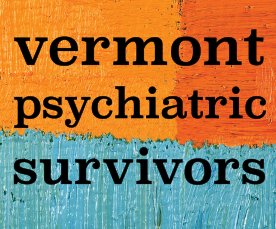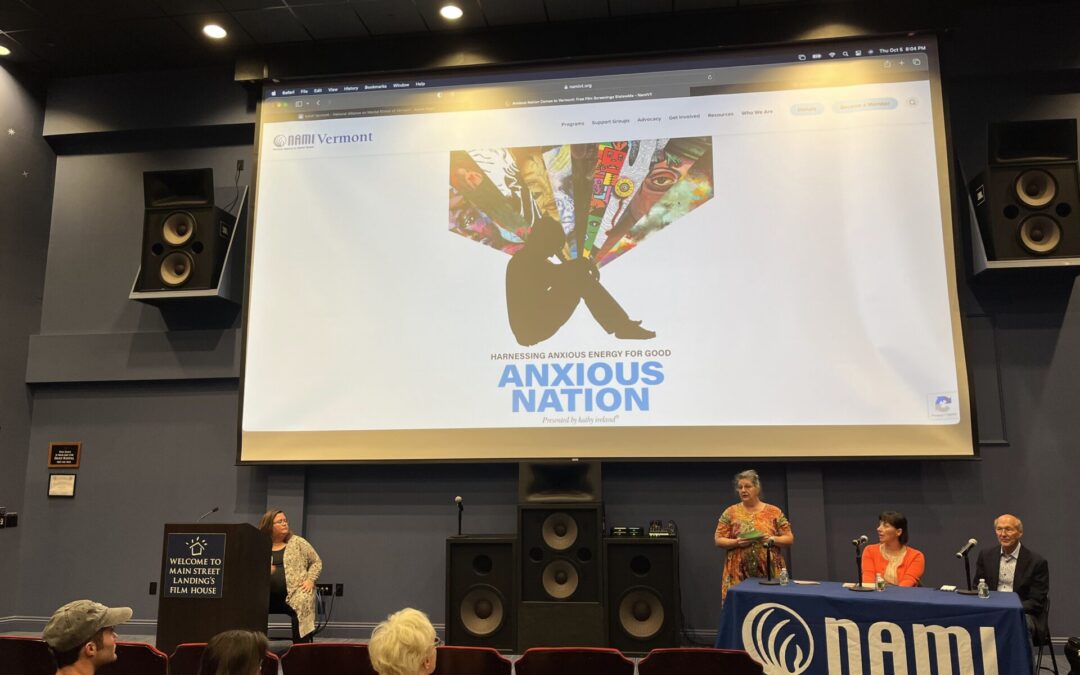What causes anxiety? What can those who experience it intensely and persistently do to ease their burden?
Anxious Nation, a documentary that played in five theaters across the state this fall in a series of special events organized by NAMI-VT, proposes the same answer to both questions. The answer is: well, a lot of stuff – it depends on the person.
Laura Morton, the mother of a teenager who suffers regularly from panic attacks, initiated the project in California. It takes an up-close look at adolescent anxiety through the eyes of young people themselves, with additional commentary by parents, clinicians, and, occasionally, celebrities.
With no prior film credits of her own, Morton brought on an experienced documentarian, Vanessa Roth, as her co-director. But much of their footage ultimately came directly from their teenage subjects, who self-recorded video diaries about their struggles.
“The pressures our kids feel, the complexities of the world, and their ability to cope with it has made anxiety impact our kids on a level we’ve never seen before,” Morton says. “So I set out to make this film to understand what our kids are going through.”
One interviewee describes anxiety as “a storm of negativity.” Others cite difficulty breathing, difficulty thinking, dread at the prospect of going to school, and suicidal ideation.
For visual interest, Morton and Roth overlay vintage cartoons that sometimes feel out of place. But in the film’s second half, particularly, Morton and Roth overlay unidentified drawings and paintings of a sometimes abstract nature. A title card in the closing credits finally discloses their poignant source: young people, like the ones in the movie, who had used art to try to capture their feelings of anxiety.
Anxious Nation begins without a clear diagnostic or prescriptive agenda, and in a seemingly genuine spirit of curiosity, it surveys a range of testimony and theory. Anxiety, it seems, has both genetic and environmental causes, the latter of which may arise from individual circumstances (for example, a child’s experience of their parents’ acrimonious divorce) or broad social phenomena (such as the threat of climate change).
Instagram and TikTok, which appear to encourage insecurity among teens who use them to compare themselves to their peers in terms of looks and popularity, also earn heavy scrutiny here. Finally, with filming ongoing, COVID-19 hits, giving everyone another big reason to worry.
Solutions, according to Anxious Nation, will vary from person to person. The filmmakers showcase talk therapy, exercise, music, and self-help strategies like journaling, as well as pharmaceutical interventions.
While debilitating hang-ups must, it seems, be defeated, the film urges against an anxiety of anxieties, emphasizing that some quantity of discomfort in the face of the world’s uncertainties is natural and healthy. Above all, it promotes open dialogue among families and a willingness to use professional help when needed.
Anxious Nation’s best quality, its open-mindedness, is also its worst: correspondingly, it has no critical perspective. It displays no interest in examining the political character of any particular conception of the “disorder” in question.
Despite a patina of race- and sexuality-based diversity, all of Anxious Nation’s teenage subjects appear, at first, to come from more or less the same bourgeois background. And their problems, therefore, are, in the filmmakers’ eyes, mostly the problems of individuals and families, not indictments of the largely wholesome world in which they live.
But then another major event transpires during production: the murder of George Floyd in Minneapolis. The subsequent nationwide protests appear to inspire the filmmakers to visit the opposite end of the socioeconomic spectrum, where they find a young man whose history of terror at the hands of both police officers and psychiatrists has left him predictably traumatized.
Anxious Nation’s liberal sensibility has no trouble correctly assigning the blame in such a case. This anxiety, obviously, originates not from a disorder of the brain but from our institutions’ careless treatment of marginalized people.
The filmmakers have nothing comparably damning to say about the documentary’s primary setting: the comfortable, professional-class milieu that, despite its promise of safety, has apparently left its kids equally paralyzed by angst. The filmmakers might have given their own home turf a second look.
One mother mentions off-handedly that she first noticed her child’s anxiety during their interviews for private kindergarten placements. At another point, a parent seems to forget the camera for a moment and begins to berate her daughter, a child actress and singer, for flubbing lines at professional auditions as she boasts about her own superior talent in the performing arts.
Here, at the edges of Anxious Nation’s relatively vanilla commentary by credentialed experts and responsibly concerned parents, one starts to perceive the more interesting stories it has chosen to leave out. They are the stories that clinical mental health has never known what to do with – the ones that reveal something about a way of life, whose deficiencies can’t be resolved through small modifications of individual behavior or attitude.
The documentary identifies what it calls a “national crisis” of rising anxiety among young people. But it’s a crisis for which no one, it seems, bears significant responsibility, and for which no truly disruptive course of action is required. We must instead use “strategies” to cope.
Anxious Nation’s most arresting segments are its recordings of crisis itself: home video footage of children undergoing severe panic attacks. It’s recognizably authentic and unfiltered, and the filmmakers offer no explanation for why it exists – why, that is, the parents continued to hold up their iPhones instead of giving their full attention to comforting their children.
In September and October, NAMI-VT sponsored free screenings of Anxious Nation in South Burlington, St. Johnsbury, Burlington, Brattleboro, and Montpelier. On Oct. 5, the Main Street Landing Performing Arts Center hosted a post-film panel discussion with Rep. Daisy Berbeco, Dr. Paul Foxman, and NAMI-VT’s Margie Lemay.
At home, viewers can rent a streaming copy of Anxious Nation at Amazon and other services.

